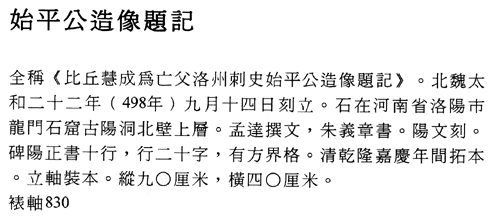 |
|
|
 |
|
|
Inscription for a
Buddhist Image Constructed to Commemorate the Duke of Shiping Northern
Wei dynasty (386�534), Taihe reign period (477�499), dated 498 Hanging
scroll, ink rubbed on paper with inscribed colophons, ink on paper; 104.7 x
54.0 cm; rubbing of engraved stele: approx. 89.9 x 41.2 cm Date
of rubbing not given, probably Qing dynasty (1644�1911) Inventory number: Biaozhou 830 This
rubbing was taken from the Guyang Cave, Longmen Grottoes, situated on the banks
of the Yellow River near Luoyang in Henan Province.� Not only is it counted among one of the Longmen ershi pin (Twenty
Outstanding Inscriptions of Longmen), it has also been canonized as one of the Longmen si
pin (Four Exemplary Inscriptions of Longmen). The
inscription on this rubbing was commissioned by the monk Huicheng to ensure the
spiritual salvation of his deceased father, the gentleman Shiping, an
aristocrat of the ruling Toba clan, whose name is absent from any other
historical record of the Northern Wei dynasty.�
Not only is the engraved panel of the finest possible quality in terms
of design and workmanship, it is also one of the rare instances in which both
the names of the calligrapher and the engraver are supplied: Zhu Yizhang and
Meng Dawen respectively.� The angular
calligraphic style with wedge-shaped dots and sharp-edged strokes is
particularly notable, as are the many variant characters.� This inscription with its chessboard grid is
also remarkable for having been cut in relief rather than in the usual
intaglio; rubbings taken from this object show the rare appearance of
characters in black ink instead of the normal white reserve. |
 |